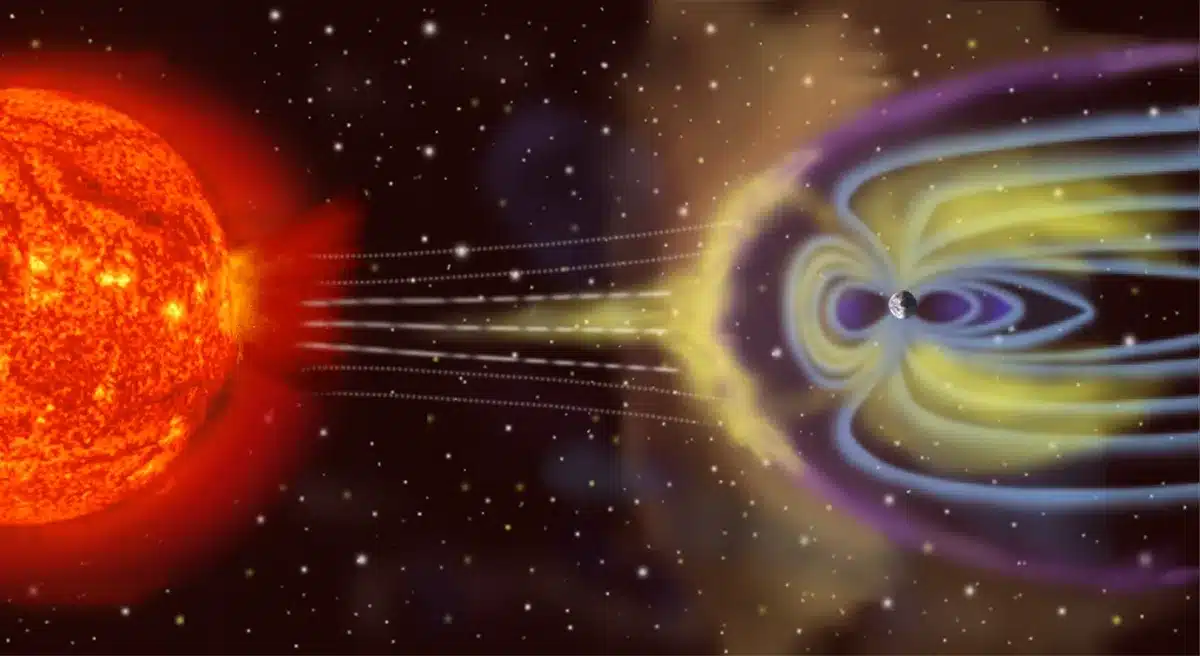About Geomagnetic Storms:
- A geomagnetic storm is a major disturbance of Earth’s magnetosphere that occurs when there is a very efficient exchange of energy from the solar wind into the space environment surrounding Earth.
- These storms result from variations in the solar wind that produce major changes in the currents, plasmas, and fields in Earth’s magnetosphere.
- The solar wind conditions that are effective for creating geomagnetic storms are sustained (for several hours) periods of the high-speed solar wind and a southward-directed solar wind magnetic field (opposite the direction of Earth’s field) at the dayside of the magnetosphere.
- The largest such storms are associated with solar coronal mass ejections (CMEs), where a billion tons or so of plasma from the sun, with its embedded magnetic field, arrives at Earth.
- Effects:
- It results in intense currents in the magnetosphere, changes in the radiation belts, and changes in the ionosphere, including heating the ionosphere and an upper atmosphere region called the thermosphere.
- These storms can heat the ionosphere, causing beautiful auroras on earth.
- Because the ionosphere is heated and distorted during storms, long-range radio communication that relies on sub-ionospheric reflection gets affected.
- Ionospheric expansion due to these storms can increase satellite drag and make their orbits difficult to control.
- Satellite electronics can be damaged through the buildup and discharge of static-electric charges.
- It can disrupt global navigation systems.
- It can create harmful geomagnetic-induced currents (GICs)in the power grid and pipelines.
What is Solar Wind?
- It is a continual stream of protons and electrons from the sun’s outermost atmosphere, the corona.
- These charged particles breeze through the solar system at speeds ranging from around 250 miles (400 kilometers) per second to 500 miles (800 km) per second, in a plasma state.
- Solar magnetic field is embedded in the plasma and flows outward with the solar wind.
- Different regions of the Sun produce solar wind of different speeds and densities.
When the solar wind reaches Earth, it sends a flurry of charged particles into the magnetosphere and along Earth’s magnetic field lines, towards the poles.
Q1: What are Coronal Mass Ejections (CMEs)?
CMEs are large expulsions of plasma and magnetic fields from the sun’s atmosphere—the corona, that propagate outward into interplanetary space. During a CME, the sun releases a colossal amount of material, including electrons, protons, and heavier ions, as well as magnetic fields. CMEs travel outward from the sun at speeds ranging from slower than 250 kilometers per second (km/s) to as fast as 3000 km/s. They expand in size as they propagate away from the Sun, and larger CMEs can reach a size comprising nearly a quarter of the space between Earth and the Sun by the time they reach our planet. CMEs, like solar flares, are most common during the solar maximum.
Source: NOAA: ‘Strong’ geomagnetic storms and auroras continue through Tuesday
Last updated on December, 2025
→ Check out the latest UPSC Syllabus 2026 here.
→ Join Vajiram & Ravi’s Interview Guidance Programme for expert help to crack your final UPSC stage.
→ UPSC Mains Result 2025 is now out.
→ UPSC Notification 2026 is scheduled to be released on January 14, 2026.
→ UPSC Calendar 2026 is released on 15th May, 2025.
→ The UPSC Vacancy 2025 were released 1129, out of which 979 were for UPSC CSE and remaining 150 are for UPSC IFoS.
→ UPSC Prelims 2026 will be conducted on 24th May, 2026 & UPSC Mains 2026 will be conducted on 21st August 2026.
→ The UPSC Selection Process is of 3 stages-Prelims, Mains and Interview.
→ UPSC Result 2024 is released with latest UPSC Marksheet 2024. Check Now!
→ UPSC Prelims Result 2025 is out now for the CSE held on 25 May 2025.
→ UPSC Toppers List 2024 is released now. Shakti Dubey is UPSC AIR 1 2024 Topper.
→ UPSC Prelims Question Paper 2025 and Unofficial Prelims Answer Key 2025 are available now.
→ UPSC Mains Question Paper 2025 is out for Essay, GS 1, 2, 3 & GS 4.
→ UPSC Mains Indian Language Question Paper 2025 is now out.
→ UPSC Mains Optional Question Paper 2025 is now out.
→ Also check Best IAS Coaching in Delhi

















